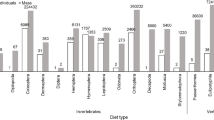Abstract
Plastic pollution is becoming an increasing issue for wildlife throughout the world. Even remote areas with relatively little human activity are affected. The Falkland Islands are a South Atlantic archipelago with a small human population (<3000), mostly concentrated in one town, Stanley. One hundred regurgitated pellets from turkey vultures (Cathartes aura) were collected in Stanley in July and August 2015 to investigate the diet and amount of anthropogenic debris (human-made artificial products) ingested. The frequency of occurrence of anthropogenic debris was 58 % of pellets for plastic, 25 % for glass, 23 % for paper, 21 % for aluminium and 3 % for fabric. Aside from anthropogenic debris, the majority of pellets were made of sheep wool (on average 29 % of the volume), feathers (19 %) and vegetation (18 %). On average, when present, anthropogenic debris corresponded to 16.1 % of the mass of each pellet, equivalent to 1.6 g. The turkey vultures are known to feed in the open-air rubbish dump near the town. This study highlights that they ingest significant amounts of anthropogenic debris. Further investigations should be undertaken to monitor and identify potential health effects. Other birds also use the dump and may be affected. Even in such remote sparsely populated islands, pollution may be a significant issue. Rubbish management could be put in place to limit birds from feeding at the dumps. A low human population density may not indicate low pollution impacts on wildlife and the environment and should be investigated further in the Falkland Islands and at other remote islands.



Similar content being viewed by others
References
Barnes DKA, Walters A, Gonçalves L (2010) Macroplastics at sea around Antarctica. Mar Environ Res 70:250–252
Benson PC, Plug I, Dobbs JC (2004) An analysis of bones and other materials collected by cape vultures at the Kransberg and Blouberg colonies, Limpopo Province, South Africa. Ostrich 75:118–132
Breen BM, Bildstein KL (2008) Distribution and abundance of the turkey vulture Cathartes Aura Falkandica in the Falkland Islands, summer 2006–2007 and autumn–winter 2007. Falklands Conservation, Stanley
Coleman JS, Fraser JD (1989) Habitat use and home ranges of black and turkey vultures. J Wildl Manag 53:782–792
Crofts S (2014) An interim report on baseline levels of beached marine debris at the Falkland Islands. Falklands Conservation, Stanley
Dwyer JF, Cockwell SG (2011) Social hierarchy of scavenging raptors on the Falkland Islands, Malvinas. J Raptor Res 45:229–235
Graves GR (1992) Greater yellow-headed vulture (Cathartes melambrotus) locates food by olfaction. J Raptor Res 26:38–39
Green DS, Boots B, Blockley DJ, Rocha C, Thompson R (2015) Impacts of discarded plastic bags on marine assemblages and ecosystem functioning. Environ Sci Technol 49:5380–5389
Houston DC, Mee A, McGrady M, Warkentin IG (2007) Why do condors and vultures eat junk? The implications for conservation. J Raptor Res 41:235–238
Kelly NE, Sparks DW, DeVault TL, Rhodes OE Jr (2007) Diet of black and turkey vultures in a forested landscape. Wilson J Ornithol 119:267–270
Mee A, Rideout BA, Hamber JA, Todd JN, Austin G, Clark M, Wallace MP (2007) Junk ingestion and nestling mortality in a reintroduced population of California condors Gymnogyps californianus. Bird Conserv Int 17:119–130
O’Neal Campbell M (2016) Vultures: their evolution, ecology and conservation. Taylor & Francis Group, LLC, Boca Raton
Provencher JF, Bond AL, Hedd A, Montevecchi WA, Muzaffar SB, Courchesne SJ, Gilchrist HG, Jamieson SE, Merkel FR, Falk K, Durinck J, Mallory ML (2014) Prevalence of marine debris in marine birds from the North Atlantic. Mar Pollut Bull 84:411–417
QGIS Development Team (2015) QGIS geographic information system. Open Source Geospatial Foundation. http://qgis.osgeo.org
Rech S, Macaya-Caquilpán V, Pantoja JF, Rivadeneira MM, Jofre Madariaga D, Thiel M (2014) Rivers as a source of marine litter—a study from the SE Pacific. Mar Pollut Bull 82:66–75
Rexer-Huber K, Bildstein KL (2012) Winter diet of striated caracara Phalcoboenus australis (Aves, Polyborinae) at a farm settlement on the Falkland Islands. Polar Biol 36:437–443
Rochman CM, Browne MA, Halpern BS, Hentschel BT, Hoh E, Karapanagioti HK, Rios-Mendoza LM, Takada H, Teh S, Thompson RC (2013) Policy: classify plastic waste as hazardous. Nature 494:169–171
Sazima I (2013) From carrion-eaters to bathers’ bags plunderers: how black vultures (Coragyps atratus) could have found that plastic bags may contain food. Braz J Ornithol 15:4
Torres-Mura JC, Lemus ML, Hertel F (2015) Plastic material in the diet of the turkey vulture (Cathartes aura) in the Atacama Desert, Chile. Wilson J Ornithol 127:134–138
Wilcox C, Sebille EV, Hardesty BD (2015) Threat of plastic pollution to seabirds is global, pervasive, and increasing. Proc Natl Acad Sci 112:11899–11904
Woods R, Woods A (1997) Atlas of breeding birds of the Falkland Islands. Anthony Nelson, Shropshire
Yorio P, Giaccardi M (2002) Urban and fishery waste tips as food sources for birds in northern coastal Patagonia, Argentina. Ornitol Neotrop 13:283–292
Acknowledgments
I would like to thank Stanley House (Falkland Islands Community School) for allowing entry to their grounds for sample collection and the Falkland Islands Government (FIG) Fisheries Department for providing their laboratory facilities (and to Dr Deborah Davidson for providing me with an induction to the laboratory). The work was conducted under Research Licence No: R13/2015 delivered by the FIG Environmental Planning Department. Thanks also go to Nathan McNally, an anonymous reviewer and the editor who all provided useful suggestions for improvement of the manuscript.
Author information
Authors and Affiliations
Corresponding author
Rights and permissions
About this article
Cite this article
Augé, A.A. Anthropogenic debris in the diet of turkey vultures (Cathartes aura) in a remote and low-populated South Atlantic island. Polar Biol 40, 799–805 (2017). https://doi.org/10.1007/s00300-016-2004-0
Received:
Revised:
Accepted:
Published:
Issue Date:
DOI: https://doi.org/10.1007/s00300-016-2004-0




